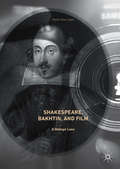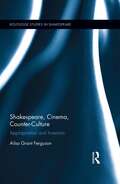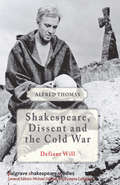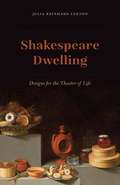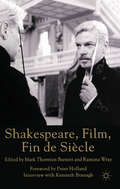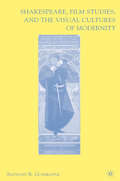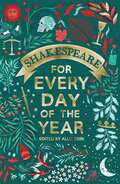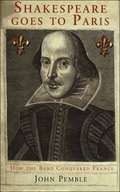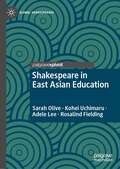- Table View
- List View
Shakespeare, Bakhtin, and Film: A Dialogic Lens
by Keith HarrisonThis book explores how Bakhtin’s ideas can illuminate the compelling but uneasy fusion of Shakespeare and cinema. With a wide variety of tones, languages, cultural orientations, and thematic concerns, film directors have updated, translated, transposed, fragmented, parodied, and geographically re-situated Shakespeare. Keith Harrison illustrates how Bakhtin’s interlinked writings in various fields can fruitfully be applied to an understanding of how the ongoing responsiveness of filmmakers to Shakespeare’s historically remote words can shape self-expressive acts of co-authoring in another medium. Through the use of such Bakhtinian concepts as the chronotope, heteroglossia, the carnivalesque, and polyphony, Harrison details how filmmakers—faithful to their specific cultures, genders, geographies, and historical moments—dialogically locate their particularity through Shakespeare’s presence.
Shakespeare, Cinema, Counter-Culture: Appropriation and Inversion (Routledge Studies in Shakespeare)
by Ailsa Grant FergusonAddressing for the first time Shakespeare’s place in counter-cultural cinema, this book examines and theorizes counter-hegemonic, postmodern, and post-punk Shakespeare in late 20th and early 21st century film. Drawing on a diverse range of case studies, Grant Ferguson presents an interdisciplinary approach that offers new theories on the nature and application of Shakespearean appropriations in the light of postmodern modes of representation. The book considers the nature of the Shakespearean inter-text in subcultural political contexts concerning the politicized aesthetics of a Shakespearean ‘body in pieces,’ the carnivalesque, and notions of Shakespeare as counter-hegemonic weapon or source of empowerment. Representative films use Shakespeare (and his accompanying cultural capital) to challenge notions of capitalist globalization, dominant socio-cultural ideologies, and hegemonic modes of expression. In response to a post-modern culture saturated with logos and semiotic abbreviations, many such films play with the emblematic imagery and references of Shakespeare’s texts. These curious appropriations have much to reveal about the elusive nature of intertextuality in late postmodern culture and the battle for cultural ownership of Shakespeare. As there has yet to be a study that isolates and theorizes modes of Shakespearean production that specifically demonstrate resistance to the social, political, ideological, aesthetic, and cinematic norms of the Western world, this book expands the dialogue around such texts and interprets their patterns of appropriation, adaptation, and representation of Shakespeare.
Shakespeare, Cinema, Counter-Culture: Appropriation and Inversion (Routledge Studies in Shakespeare #17)
by Ailsa Grant FergusonAddressing for the first time Shakespeare’s place in counter-cultural cinema, this book examines and theorizes counter-hegemonic, postmodern, and post-punk Shakespeare in late 20th and early 21st century film. Drawing on a diverse range of case studies, Grant Ferguson presents an interdisciplinary approach that offers new theories on the nature and application of Shakespearean appropriations in the light of postmodern modes of representation. The book considers the nature of the Shakespearean inter-text in subcultural political contexts concerning the politicized aesthetics of a Shakespearean ‘body in pieces,’ the carnivalesque, and notions of Shakespeare as counter-hegemonic weapon or source of empowerment. Representative films use Shakespeare (and his accompanying cultural capital) to challenge notions of capitalist globalization, dominant socio-cultural ideologies, and hegemonic modes of expression. In response to a post-modern culture saturated with logos and semiotic abbreviations, many such films play with the emblematic imagery and references of Shakespeare’s texts. These curious appropriations have much to reveal about the elusive nature of intertextuality in late postmodern culture and the battle for cultural ownership of Shakespeare. As there has yet to be a study that isolates and theorizes modes of Shakespearean production that specifically demonstrate resistance to the social, political, ideological, aesthetic, and cinematic norms of the Western world, this book expands the dialogue around such texts and interprets their patterns of appropriation, adaptation, and representation of Shakespeare.
The Shakespeare Codex (Modern Plays)
by Terry PratchettBased loosely on The Science of Discworld II: the Globe, Lords & Ladies, and A Midsummer Night's Dream, The Shakespeare Codex is a new Discworld stage adaptation written to commemorate Terry Pratchett's life and works.Discworld's motley band of characters team up and stop the elves taking over our world, make Shakespeare write A Midsummer Night's Dream ... and ensure the potato is discovered! Featuring Ridcully, Rincewind, Granny Weatherwax, Angua, Vetinari, Shakespeare, Queen Elizabeth I (and the Earl of Oxford), this is an unmissable new adventure for Discworld fans.
The Shakespeare Codex (Modern Plays)
by Terry PratchettBased loosely on The Science of Discworld II: the Globe, Lords & Ladies, and A Midsummer Night's Dream, The Shakespeare Codex is a new Discworld stage adaptation written to commemorate Terry Pratchett's life and works.Discworld's motley band of characters team up and stop the elves taking over our world, make Shakespeare write A Midsummer Night's Dream ... and ensure the potato is discovered! Featuring Ridcully, Rincewind, Granny Weatherwax, Angua, Vetinari, Shakespeare, Queen Elizabeth I (and the Earl of Oxford), this is an unmissable new adventure for Discworld fans.
Shakespeare & Company: When Action is Eloquence
by Bella Merlin Tina PackerShakespeare & Company: When Action is Eloquence is the first comprehensive insight into this internationally acclaimed company founded in 1978 in Lenox, Massachusetts, by actor-director Tina Packer and voice pioneer Kristin Linklater, with the transformative power of Shakespeare’s language at its heart. Why act Shakespeare? What’s his relevance in the twenty-first century? Compelling answers to these questions lie at the center of this highly accessible journey into Shakespeare & Company’s aesthetics and practice. Drawing on hitherto unpublished material – including notebooks, lectures, interviews, rehearsal diaries – and the Company’s newly collated archive, this book provides insight into a working theatre company and sheds light on the role Shakespeare plays in our modern world. It also details: Shakespeare & Company’s founding and early history Its aesthetic based on the Elizabethan theatre’s principles of the Art of Rhetoric; Structure of the Verse; Voice and Movement; Clown; Fight; and Actor/Audience Relationship Vocational components of its Training Intensives Practical pedagogy of its Education programs Insights into its unique approaches to Performance Impact and legacy of its three lifetime founding members: Dennis Krausnick (Director of Training), Kevin G. Coleman (Director of Education) and Tina Packer (founding artistic director). Actors, directors, students, educators, scholars and theatre-lovers alike will find practical acting strategies, inspirational approaches to theatre making and lively insights into the sustaining of a unique and robust theatre company that has been thriving for over 40 years.
Shakespeare & Company: When Action is Eloquence
by Bella Merlin Tina PackerShakespeare & Company: When Action is Eloquence is the first comprehensive insight into this internationally acclaimed company founded in 1978 in Lenox, Massachusetts, by actor-director Tina Packer and voice pioneer Kristin Linklater, with the transformative power of Shakespeare’s language at its heart. Why act Shakespeare? What’s his relevance in the twenty-first century? Compelling answers to these questions lie at the center of this highly accessible journey into Shakespeare & Company’s aesthetics and practice. Drawing on hitherto unpublished material – including notebooks, lectures, interviews, rehearsal diaries – and the Company’s newly collated archive, this book provides insight into a working theatre company and sheds light on the role Shakespeare plays in our modern world. It also details: Shakespeare & Company’s founding and early history Its aesthetic based on the Elizabethan theatre’s principles of the Art of Rhetoric; Structure of the Verse; Voice and Movement; Clown; Fight; and Actor/Audience Relationship Vocational components of its Training Intensives Practical pedagogy of its Education programs Insights into its unique approaches to Performance Impact and legacy of its three lifetime founding members: Dennis Krausnick (Director of Training), Kevin G. Coleman (Director of Education) and Tina Packer (founding artistic director). Actors, directors, students, educators, scholars and theatre-lovers alike will find practical acting strategies, inspirational approaches to theatre making and lively insights into the sustaining of a unique and robust theatre company that has been thriving for over 40 years.
Shakespeare, Dissent and the Cold War (Palgrave Shakespeare Studies)
by Alfred ThomasShakespeare, Dissent and the Cold War is the first book to read Shakespeare's drama through the lens of Cold War politics. The book uses the Cold War experience of dissenting artists in theatre and film to highlight the coded religio-political subtexts in Hamlet, King Lear, Macbeth and The Winter's Tale.
Shakespeare Dwelling: Designs for the Theater of Life
by Julia Reinhard LuptonGreat halls and hovels, dove-houses and sheepcotes, mountain cells and seaside shelters—these are some of the spaces in which Shakespearean characters gather to dwell, and to test their connections with one another and their worlds. Julia Reinhard Lupton enters Shakespeare’s dwelling places in search of insights into the most fundamental human problems. Focusing on five works (Romeo and Juliet, Macbeth, Pericles, Cymbeline, and The Winter’s Tale), Lupton remakes the concept of dwelling by drawing on a variety of sources, including modern design theory, Renaissance treatises on husbandry and housekeeping, and the philosophies of Hannah Arendt and Martin Heidegger. The resulting synthesis not only offers a new entry point into the contemporary study of environments; it also shows how Shakespeare’s works help us continue to make sense of our primal creaturely need for shelter.
Shakespeare Dwelling: Designs for the Theater of Life
by Julia Reinhard LuptonGreat halls and hovels, dove-houses and sheepcotes, mountain cells and seaside shelters—these are some of the spaces in which Shakespearean characters gather to dwell, and to test their connections with one another and their worlds. Julia Reinhard Lupton enters Shakespeare’s dwelling places in search of insights into the most fundamental human problems. Focusing on five works (Romeo and Juliet, Macbeth, Pericles, Cymbeline, and The Winter’s Tale), Lupton remakes the concept of dwelling by drawing on a variety of sources, including modern design theory, Renaissance treatises on husbandry and housekeeping, and the philosophies of Hannah Arendt and Martin Heidegger. The resulting synthesis not only offers a new entry point into the contemporary study of environments; it also shows how Shakespeare’s works help us continue to make sense of our primal creaturely need for shelter.
Shakespeare Dwelling: Designs for the Theater of Life
by Julia Reinhard LuptonGreat halls and hovels, dove-houses and sheepcotes, mountain cells and seaside shelters—these are some of the spaces in which Shakespearean characters gather to dwell, and to test their connections with one another and their worlds. Julia Reinhard Lupton enters Shakespeare’s dwelling places in search of insights into the most fundamental human problems. Focusing on five works (Romeo and Juliet, Macbeth, Pericles, Cymbeline, and The Winter’s Tale), Lupton remakes the concept of dwelling by drawing on a variety of sources, including modern design theory, Renaissance treatises on husbandry and housekeeping, and the philosophies of Hannah Arendt and Martin Heidegger. The resulting synthesis not only offers a new entry point into the contemporary study of environments; it also shows how Shakespeare’s works help us continue to make sense of our primal creaturely need for shelter.
Shakespeare Dwelling: Designs for the Theater of Life
by Julia Reinhard LuptonGreat halls and hovels, dove-houses and sheepcotes, mountain cells and seaside shelters—these are some of the spaces in which Shakespearean characters gather to dwell, and to test their connections with one another and their worlds. Julia Reinhard Lupton enters Shakespeare’s dwelling places in search of insights into the most fundamental human problems. Focusing on five works (Romeo and Juliet, Macbeth, Pericles, Cymbeline, and The Winter’s Tale), Lupton remakes the concept of dwelling by drawing on a variety of sources, including modern design theory, Renaissance treatises on husbandry and housekeeping, and the philosophies of Hannah Arendt and Martin Heidegger. The resulting synthesis not only offers a new entry point into the contemporary study of environments; it also shows how Shakespeare’s works help us continue to make sense of our primal creaturely need for shelter.
Shakespeare Dwelling: Designs for the Theater of Life
by Julia Reinhard LuptonGreat halls and hovels, dove-houses and sheepcotes, mountain cells and seaside shelters—these are some of the spaces in which Shakespearean characters gather to dwell, and to test their connections with one another and their worlds. Julia Reinhard Lupton enters Shakespeare’s dwelling places in search of insights into the most fundamental human problems. Focusing on five works (Romeo and Juliet, Macbeth, Pericles, Cymbeline, and The Winter’s Tale), Lupton remakes the concept of dwelling by drawing on a variety of sources, including modern design theory, Renaissance treatises on husbandry and housekeeping, and the philosophies of Hannah Arendt and Martin Heidegger. The resulting synthesis not only offers a new entry point into the contemporary study of environments; it also shows how Shakespeare’s works help us continue to make sense of our primal creaturely need for shelter.
Shakespeare Dwelling: Designs for the Theater of Life
by Julia Reinhard LuptonGreat halls and hovels, dove-houses and sheepcotes, mountain cells and seaside shelters—these are some of the spaces in which Shakespearean characters gather to dwell, and to test their connections with one another and their worlds. Julia Reinhard Lupton enters Shakespeare’s dwelling places in search of insights into the most fundamental human problems. Focusing on five works (Romeo and Juliet, Macbeth, Pericles, Cymbeline, and The Winter’s Tale), Lupton remakes the concept of dwelling by drawing on a variety of sources, including modern design theory, Renaissance treatises on husbandry and housekeeping, and the philosophies of Hannah Arendt and Martin Heidegger. The resulting synthesis not only offers a new entry point into the contemporary study of environments; it also shows how Shakespeare’s works help us continue to make sense of our primal creaturely need for shelter.
Shakespeare, Film, Fin de Siecle
by Mark Thornton Burnett Ramona WrayThe essays in this volume read the Shakespeare films of the 1990s as key instruments with which western culture confronts the anxieties attendant upon the transition from one century to another. Such films as Hamlet, Love's Labour's Lost, Othello, Shakespeare in Love and William Shakespeare's Romeo and Juliet , the contributors maintain, engage with some of the most pressing concerns of the present, apocalyptic condition - familial crisis, social estrangement, urban blight, cultural hybridity, literary authority, the impact of technology and the end of history. The volume includes an exclusive interview with Kenneth Branagh.
Shakespeare, Film Studies, and the Visual Cultures of Modernity
by A. GuneratneThis book is the first in-depth cultural history of cinema's polyvalent and often contradictory appropriations of Shakespearean drama and performance traditions. The author argues that these adapatations have helped shape multiple aspects of film, from cinematic style to genre and narrative construction.
Shakespeare for Every Day of the Year
by Allie EsiriFrom Allie Esiri, editor of the bestselling A Poem for Every Day of the Year and A Poem for Every Night of the Year, comes this beautiful gift anthology of Shakespeare's works.William Shakespeare wrote at least 37 plays, 154 sonnets and a handful of longer poems and you can discover them all here. Each page of this unique collection contains an extract, which might be a famous poem, quote or scene, matched to the date. Allie Esiri's introductions give her readers a new window into the work, time and life of the greatest writer in the English language. Shakespeare for Every Day of the Year is perfect for reading or sharing and brings you Shakespeare’s best-known and best-loved classics alongside lesser known extracts. Esiri’s entertaining and insightful thoughts on each entry will fill your year with wonder, laughter, wisdom and wit.
Shakespeare for the wiser sort: Solving Shakespeare's riddles in The Comedy of Errors, Romeo and Juliet, King John, 1-2 Henry IV, The Merchant of Venice, Henry V, Julius Caesar, Othello, Macbeth, and Cymbeline
by Steve SohmerWilliam Shakespeare’s plays are riddled with passages, scenes and sudden plot twists which baffle and confound the most devoted playgoer and the most attentive commentator. Why, for example, didn’t Hamlet succeed to the throne of Denmark at the instant of his father’s death? (It’s not because the Danish throne was elective.) Why does Chorus in Romeo and Juliet promise his audience ‘two houres trafficke of our stage’ when the play obviously runs almost three hours? How is it that Old Hamlet sent his son to school in (Protestant) Wittenberg but his Ghost was sent to (Catholic) Purgatory? and is there cause-and-effect here? How can Lancelot Gobbo be correct (and he is) when he claims Black Monday (the day after Easter) and Ash Wednesday (the 41st day before Easter) once fell on the same day? And what is a ‘dram of eale’? This engaging and lucid book solves these tantalizing riddles and many others.
Shakespeare Goes to Paris
by John PembleIt has sometimes been assumed that the difficulty of translating Shakespeare into French has meant that he has had little influence in France. Shakespeare Goes to Paris proves the opposite. Virtually unknown in France in his lifetime, and for well over a hundred years after his death, Shakespeare was discovered in the first half of the eighteenth century, as part of a growing French interest in England. Since then, Shakespeare's impact in France has been enormous. Writers, from Voltaire to Gide, found themsleves baffled, frustrated, mesmerised but overawed by a playwright who broke all the rules of French classical theatre and challenged the primacy of French culture. Attempts to tame and translate him alternated with uncritical idolisation, such as that of Berlioz and Hugo. Changing attitudes to Shakespeare have also been an index of French self-esteem, as John Pemble shows in his sparkingly written book
The Shakespeare Handbook (Literature and Culture Handbooks)
by Andrew Hiscock Stephen LongstaffeLiterature and Culture Handbooks are an innovative series of guides to major periods, topics and authors in British and American literature and culture. Designed to provide a comprehensive, one-stop resource for literature students, each handbook provides the essential information and guidance needed from the beginning of a course through to developing more advanced knowledge and skills. Written in clear language by leading academics, they provide an indispensable introduction to key topics, including: Introduction to authors, texts, historical and cultural contexts Guides to key critics, concepts and topics An overview of major critical approaches, changes in the canon and directions of current and future research Case studies in reading literary and critical texts Annotated bibliography (including websites), timeline, glossary of critical terms.The Shakespeare Handbook is an accessible and comprehensive introduction to Shakespeare and early modern literature.
The Shakespeare Handbook (Literature And Culture Handbooks Ser.)
by Andrew Hiscock Stephen LongstaffeLiterature and Culture Handbooks are an innovative series of guides to major periods, topics and authors in British and American literature and culture. Designed to provide a comprehensive, one-stop resource for literature students, each handbook provides the essential information and guidance needed from the beginning of a course through to developing more advanced knowledge and skills. Written in clear language by leading academics, they provide an indispensable introduction to key topics, including: • Introduction to authors, texts, historical and cultural contexts • Guides to key critics, concepts and topics • An overview of major critical approaches, changes in the canon and directions of current and future research • Case studies in reading literary and critical texts • Annotated bibliography (including websites), timeline, glossary of critical terms.The Shakespeare Handbook is an accessible and comprehensive introduction to Shakespeare and early modern literature.
Shakespeare in Cuba: Caliban’s Books (Global Shakespeares)
by Donna Woodford-GormleyShakespeare in Cuba: Caliban’s Books explores how Shakespeare is consumed and appropriated in Cuba. It contributes to the underrepresented field of Latin American Shakespeares by applying the lens of cultural anthropophagy, a theory with Latin American roots, to explore how Cuban artists ingest and transform Shakespeare’s plays. By consuming these works and incorporating them into Cuban culture and literature, Cuban writers make the plays their own while also nourishing the source texts and giving Shakespeare a new afterlife.
Shakespeare in East Asian Education (Global Shakespeares)
by Adele Lee Rosalind Fielding Sarah Olive Uchimaru KoheiThis book offers fresh, critical insights into Shakespeare in Hong Kong, Japan, and Taiwan. It recognises that Shakespeare in East Asian education is not confined to the classroom or lecture hall but occurs on diverse stages. It covers multiple aspects of education: policy, pedagogy, practice, and performance. Beyond researchers in these areas, this book is for those teaching and learning Shakespeare in the region, those teaching and learning English as an Additional Language anywhere in the world, and those making educational policies, resources, or theatre productions with young people in East Asia.
Shakespeare in Elizabethan Costume: 'Period Dress' in Twenty-First-Century Performance
by Ella HawkinsThe meanings originally communicated by Elizabethan and Jacobean dress have long been confined to history. Why, then, have doublets, hose, ruffs and farthingales featured in many Shakespeare productions staged since the turn of the 21st century?This book scrutinizes the popular practice of costuming Shakespeare's plays in Elizabethan and Jacobean dress. It considers why this approach to design appeals to contemporary directors, designers and audiences, and how it has shaped the meaning of Shakespeare's works in specific performance contexts. Informed by original interviews with several prominent theatre practitioners, including Emma Rice, Gregory Doran, Jenny Tiramani, Simon Godwin, Stephen Brimson Lewis and Tom Piper, Shakespeare in Elizabethan Costume explores how various 21st-century Shakespeare productions have drawn on myths and desires associated with early modern clothing. Its discussions range from the practicalities of historical reconstruction to the appeal of early modern sartorial culture as an embodiment of wonder, spectacle and the supernatural. Productions discussed include Shakespeare's Globe's production of Henry V (1997), the National Theatre's Twelfth Night (2017) and the Royal Shakespeare Company's The Tempest (2016). Ella Hawkins examines the minutiae of modern design -- how seams are sewn, whence fabrics are sourced -- as well as the widespread cultural movements that have produced our modern relationship with the period of Shakespeare's lifetime. This is the first book to explore fully the significance of Elizabethan-inspired design in contemporary Shakespearean performance. Shakespeare in Elizabethan Costume reframes so-called 'period' costuming as a dynamic collection of practices capable of refashioning textual meanings, reflecting present-day political and societal shifts and confronting contemporary injustices.
Shakespeare in Elizabethan Costume: 'Period Dress' in Twenty-First-Century Performance
by Ella HawkinsThe meanings originally communicated by Elizabethan and Jacobean dress have long been confined to history. Why, then, have doublets, hose, ruffs and farthingales featured in many Shakespeare productions staged since the turn of the 21st century?This book scrutinizes the popular practice of costuming Shakespeare's plays in Elizabethan and Jacobean dress. It considers why this approach to design appeals to contemporary directors, designers and audiences, and how it has shaped the meaning of Shakespeare's works in specific performance contexts. Informed by original interviews with several prominent theatre practitioners, including Emma Rice, Gregory Doran, Jenny Tiramani, Simon Godwin, Stephen Brimson Lewis and Tom Piper, Shakespeare in Elizabethan Costume explores how various 21st-century Shakespeare productions have drawn on myths and desires associated with early modern clothing. Its discussions range from the practicalities of historical reconstruction to the appeal of early modern sartorial culture as an embodiment of wonder, spectacle and the supernatural. Productions discussed include Shakespeare's Globe's production of Henry V (1997), the National Theatre's Twelfth Night (2017) and the Royal Shakespeare Company's The Tempest (2016). Ella Hawkins examines the minutiae of modern design -- how seams are sewn, whence fabrics are sourced -- as well as the widespread cultural movements that have produced our modern relationship with the period of Shakespeare's lifetime. This is the first book to explore fully the significance of Elizabethan-inspired design in contemporary Shakespearean performance. Shakespeare in Elizabethan Costume reframes so-called 'period' costuming as a dynamic collection of practices capable of refashioning textual meanings, reflecting present-day political and societal shifts and confronting contemporary injustices.
